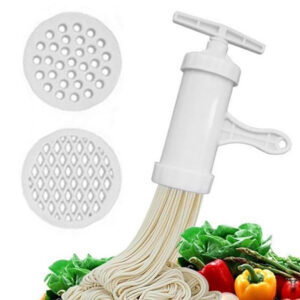
Plastic pasta makers are among the most popular types of pasta makers on the market today. They are affordable, lightweight, and come in a variety of colors and designs. However, like any product, plastic pasta makers have their pros and cons.
Pros of Plastic Pasta Makers
Affordability:
One of the biggest advantages of plastic pasta makers is their affordability. Compared to stainless steel pasta makers, plastic models are typically much cheaper, making them a great option for those who are on a tight budget.
Lightweight:
Another advantage of plastic pasta makers is that they are lightweight and easy to use. This is especially important for those who have limited space in their kitchen or who don’t want to spend too much time in the kitchen.
Variety:
Plastic pasta makers come in a variety of colors and designs. This means that you can choose one that matches your kitchen decor or your personal style. This is a great way to add a touch of personality to your kitchen.
Easy to clean:
Plastic pasta makers are easy to clean and maintain. They can be wiped clean with a damp cloth or sponge, making them a convenient choice for those who are busy or who don’t want to spend too much time cleaning their kitchen appliances.
BPA-free:
Many plastic pasta makers are made with BPA-free plastic. BPA is a chemical that has been linked to a number of health problems, so choosing a BPA-free model can help you avoid these risks.
Cons of Plastic Pasta Makers
Durability:
One of the biggest disadvantages of plastic pasta makers is their durability. Plastic is a relatively soft material, which means that it is more prone to warping and cracking over time. This can be especially problematic for those who plan to use their pasta maker frequently.
Quality:
The quality of plastic pasta makers may not be as high as that of their stainless steel counterparts. Plastic rollers and cutters may not produce pasta dough that is as smooth or even as that produced by a stainless steel pasta maker. This can result in pasta that is not as uniform in texture or appearance.
Hygiene:
Another potential issue with plastic pasta makers is their hygiene. Plastic is a porous material, which means that it can absorb flavors and odors from previous batches of pasta. This can lead to cross-contamination and affect the taste of your pasta.
Limited Performance:
Plastic pasta makers may not be able to handle large batches of pasta dough, and they may not be able to create as many pasta shapes as stainless steel pasta makers. This can be a limitation for those who want to experiment with a wide range of pasta shapes and sizes.
Environmental Impact:
Finally, there is the issue of the environmental impact of plastic pasta makers. Plastic is not biodegradable, which means that it can take hundreds of years to break down in a landfill. This can contribute to environmental problems and impact the health of our planet.
Plastic pasta makers have their pros and cons, and the decision about whether or not to choose one over a stainless steel model will depend on your needs, budget, and preferences. If you are a beginner looking for an affordable and convenient way to make pasta, a plastic pasta maker may be a good option. However, if you want a durable, high-quality pasta maker that will last for years and produce uniform pasta dough, a stainless steel pasta maker may be a better investment. Whatever your choice, making homemade pasta is a fun and rewarding experience that can bring a touch of Italy to your kitchen.